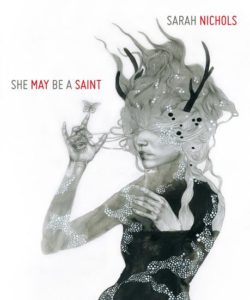
She May Be a Saint, Sarah Nichols’s most recent chapbook offering, is a collection of centos derived from the work of two influential poets. A form that can be traced as far back as ancient Greece, the cento consists of poetic lines sourced from two or more writers, recombined to create something which stands independent of its sources. Nichols draws from the collected works of Sylvia Plath and selected works by C.D. Wright. These sources are meticulously documented, down to specific citations for the titles of most poems in the collection. Perhaps more importantly, from the perspective of craft, these poems have a life of their own; they have a story to tell that belongs not to the source authors, but to Nichols herself.
The source for the title of the opening poem, “Once I Was,” is Plath’s “Poems for a Birthday: Maenad.” The maenad—wild, sometimes violent attendants of Bacchus—can be demonic in appearance but is ultimately divine. This archetype works well as the virtual speaker throughout the collection—clearly female, clearly tortured. We see this dichotomous nature on the cover; Patricia Ariel’s black and white “Revelation” suggests that there may be more to her horned, fiery-haired figure than a passing glance would suggest. Closer examination reveals flowing water, a butterfly (transformation), entanglement, and the all-seeing eye. Nichols’s title also serves to tell us that we need to look past the surface and find what is holy in these poems.
Throughout the collection, Nichols’s maenad speaks of her pain, and also of her rich internal life—her saintly aspect that may not be readily apparent. Nearly every poem intimates the speaker’s barely suppressed outrage—burned, wire, coil, carbon, gas, explosion. This speaker is placing virtual bombs, set to detonate at the slightest movement. She is also a true follower of Bacchus. In “The Wire”, we are invited to “a hotel of / relapse”; in the title poem “assistants / count the pills, / poppy sleepy.” Both incidental to Plath and integral to this speaker, our maenad knows the destructive dance of self-medication.
But Nichols wants us to know that, like every woman scorned, whether by an individual or by society, her maenad was initially innocent and loving. Beneath a scarred exterior, that innocent still resides. If we are looking, we will find this most clearly in Nichols’s declarative titles—“Once I Was,” “In Bloom,” or “I Would Open.” Her speaker is trying to write her way back to joy—“I /drafted a / fictitious life /…Words to rid me / of / me.” She explores a host of characters in her journey to do so; she “…inhabit[s] / a / doll’s body”; she channels Gretel in “Distances Evaporate”—“…I / dropped crumbs of / fresh paper”; she is the Sphinx in “Experiences, quietly humming”—“with her / lion-red body / her wings of glass”; she takes a demon/vampire lover in “Her First Dream of Him”—“God bit me. /….He shrieks, / full of wings.”
As readers and writers, we look for versions of ourselves in literature. In electing to use the cento, Nichols makes for us a connection between the borrowing of lines and the borrowing that occurs as we construct our identities as readers and writers. What do we find that resonates with our own emotional landscape? Who do we admire for their values? Their observations? Their facility with language? Every serious reader finds herself through exploring what has come before and selecting the pieces that fit. Through cento, Nichols shares her profound admiration for the work of these poetry icons. By lifting and repurposing their words she demonstrates the ways in which their language and teachings have shaped her worldview.
At the same time, Nichols is successful in creating work that departs from her sources. Cento is tolerant of extended borrowing, and there are phrases in Nichols’s poems long and distinct enough to be traced back to Plath, yet these sparse, vertical poems bear no visual or sonic relation to Plath’s more narrative style. Even if specific lines were not obvious, these poems resonate with Plath thematically. The connection to Wright is less distinct; it takes a side-by-side analysis of source pieces to determine what has been borrowed from Wright’s work, causing the meticulous reader to reflect on the ownership of words and the requirements of attribution. While this is a delicate line to walk, it represents one of the best qualities of well-managed found poetry, and emphasizes the success of this chapbook: to honor the source while creating something new in its image.





